The Italy Faith Based Tourism Market is estimated to be valued at USD 95.3 million in 2025 and is projected to reach USD 242.8 million by 2035, registering a compound annual growth rate (CAGR) of 9.8% over the forecast period.
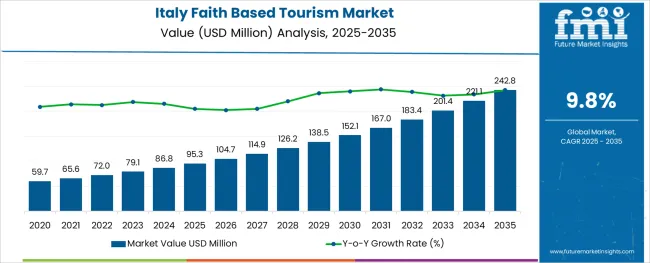
The Italy faith based tourism market is witnessing sustained momentum as religious and spiritual travel continues to evolve beyond traditional pilgrimages to immersive, culturally rich experiences. This growth is being propelled by a combination of renewed interest in heritage travel, increased institutional support from religious organizations, and rising inbound arrivals seeking sacred sites and religious festivals.
The Italian government’s preservation initiatives for churches, monasteries, and historical pilgrimage routes are enhancing accessibility and international appeal. Additionally, the convergence of spirituality with wellness, education, and community engagement is expanding the demographic appeal of faith-based travel across age groups and nationalities.
Digital platforms and curated experiences are also making it easier for travelers to discover and book structured religious tours and local retreats. As post-pandemic travel rebounds, opportunities for faith tourism in Italy are expected to increase with a focus on authenticity, local participation, and sustainable engagement with sacred heritage.
The market is segmented by Tourism Type, Consumer Orientation, Tour Type, Booking Channel, Tourist Type, and Age Group and region. By Tourism Type, the market is divided into Day Trips & Local Gateways, Museums, Pilgrimages, Religious and Heritage Tours, and Others. In terms of Consumer Orientation, the market is classified into Women, Children, and Men. Based on Tour Type, the market is segmented into Tour Groups, Package Travelers, and Independent Travelers. By Booking Channel, the market is divided into Online Booking, In Person Booking, and Phone Booking. By Tourist Type, the market is segmented into Domestic and International. By Age Group, the market is segmented into 36-45 Years, 46-55 Years, 66-75 Years, 15-25 Years, and 26-35 Years. Regionally, the market is classified into North America, Latin America, Western Europe, Eastern Europe, Balkan & Baltic Countries, Russia & Belarus, Central Asia, East Asia, South Asia & Pacific, and the Middle East & Africa.
The market is segmented by Tourism Type, Consumer Orientation, Tour Type, Booking Channel, Tourist Type, and Age Group and region. By Tourism Type, the market is divided into Day Trips & Local Gateways, Museums, Pilgrimages, Religious and Heritage Tours, and Others. In terms of Consumer Orientation, the market is classified into Women, Children, and Men. Based on Tour Type, the market is segmented into Tour Groups, Package Travelers, and Independent Travelers. By Booking Channel, the market is divided into Online Booking, In Person Booking, and Phone Booking. By Tourist Type, the market is segmented into Domestic and International. By Age Group, the market is segmented into 36-45 Years, 46-55 Years, 66-75 Years, 15-25 Years, and 26-35 Years. Regionally, the market is classified into North America, Latin America, Western Europe, Eastern Europe, Balkan & Baltic Countries, Russia & Belarus, Central Asia, East Asia, South Asia & Pacific, and the Middle East & Africa.
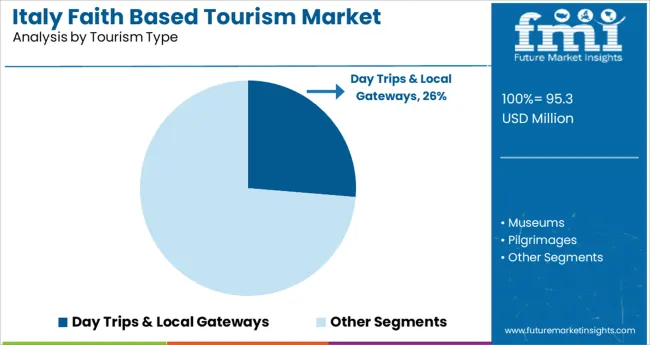
In the tourism type category, day trips and local gateways are anticipated to contribute 26.3% of total revenue in 2025, marking them as a significant component of faith-based travel experiences in Italy. Their growth has been supported by the increasing preference for short, spiritually enriching journeys among both domestic and international tourists.
The accessibility of local shrines, historical religious sites, and cultural heritage zones enables travelers to engage in meaningful religious experiences without the need for extended stays. Flexibility, cost-effectiveness, and the growing popularity of micro-tourism have made this format ideal for those seeking reflective journeys within manageable timeframes.
The influence of local dioceses and community-led religious events has further promoted this segment, particularly among travelers who prefer self-guided or lightly facilitated day-long itineraries that combine spirituality with cultural immersion.
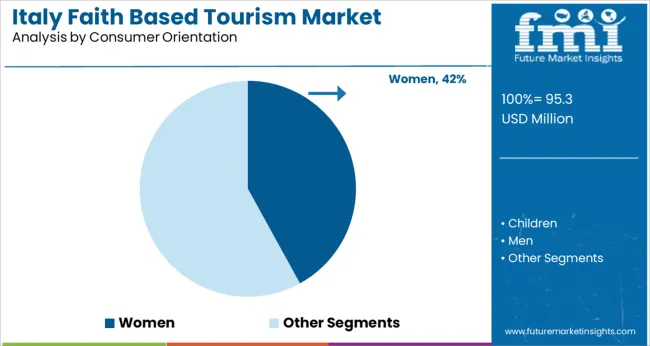
Women are projected to represent 42.0% of the market share by 2025 within the consumer orientation segment, making them the most prominent traveler demographic in Italy's faith based tourism market. This prominence is attributed to their growing participation in organized spiritual retreats, religious pilgrimages, and culturally anchored group tours.
Social dynamics, including women-led prayer groups, community pilgrimages, and solo spiritual exploration, have contributed to this upward trend. Additionally, travel companies and religious institutions have tailored their offerings to accommodate safety, wellness, and social connection priorities specific to female travelers.
Wellness-integrated spiritual tourism, female-only pilgrimage packages, and culturally respectful experiences have further supported growth in this demographic. As empowerment, safety, and access improve across travel services, the participation of women in faith based tourism is expected to rise steadily.
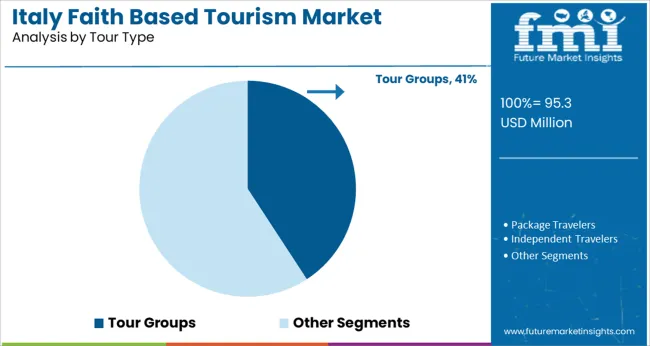
Tour groups are expected to account for 40.8% of the total revenue share by 2025 in the tour type category, securing their position as the leading format for religious travel in Italy. This leadership is being driven by the structured nature of group travel, which offers logistical convenience, shared experiences, and deeper engagement with sacred traditions.
Tour operators have been instrumental in developing itineraries that blend spiritual heritage, historical context, and communal rituals, all of which appeal strongly to group travelers. Religious organizations, churches, and travel agencies continue to promote pilgrimage tours through chartered groups, which benefit from guided narration, pre-arranged access, and coordinated accommodations.
The sense of fellowship and shared belief often enhances the overall experience, making group tours the preferred choice for many faith-based travelers. Continued institutional support and growing interest from international communities are expected to further solidify this segment’s dominance.
The Italy faith-based tourism market exhibited growth at a CAGR of 9.5% in the historical period from 2020 to 2024. In 2020, the tourism sector accounted for 13.0 percent of the GDP and employed nearly 14.7 percent of the workforce.
In 2020, the tourism sector directly employed about 2.0 million people, accounting for 8.3 percent of the total employment. Italy attracts tens of millions of visitors from all over the world each year due to its 7600 kilometers of coastline and location on the Mediterranean Sea.
Citizens of northern European countries, in particular, are attracted to Italy owing to its serene atmosphere and religious tourist destinations. Rising disposable income and the need to travel to ancient religious places are expected to push growth in the spiritual tourism industry in Italy during the forecast period.
Presence of the Italian Catholic Church
The majority of Italy's cultural legacy consists of sanctuaries, churches, monuments, and symbols of popular art, devotion, and piety. The general inventory of the Italian Catholic heritage includes more than 64,000 monuments and other properties classified as ‘houses of worship,’ as well as more than 4 million historic and artistic heritage objects.
The Catholic Church represents 93% of all Christians in Italy. Vatican City is located within Italian territory and will have a significant impact on the expansion of the Catholic Church in the country.
Besides, the presence of headquarters of various Catholic groups, including Dominicans, Benedictines, Franciscans, Jesuits, Redemptorists, Silesians, and Divine Word Missionaries, especially in Rome, is set to drive the market.
The Emergence of New Religious Attractions
Owing to its rich cultural and regional customs, Italy is considered to be one of the most famous tourist destinations in Europe. Pilgrimages and visits to the Marian shrine have increased significantly in recent years in Italy.
A considerable number of tourists visit churches, cathedrals, and shrines, as well as attend religious-themed festivals and activities. As a result, new religious tourism attractions are sprouting and demand is no longer limited to churches.
Adoption of Social Media for Promotional Activities
The digital revolution, particularly since the advent of mobile devices like tablets & smartphones and the proliferation of Web 2.0, has had a significant influence on the structure of society and the economy in recent years. Social media platforms play an important role in the tourism industry, both in terms of demand and supply.
These are valuable sources of information for tourists, allowing destination owners to socialize and exchange information and opinions with users and potential guests. Using social media to promote remote locations has proved to be a good marketing tactic. Thus, tour operators are expected to use social media platforms to promote and incentivize pilgrimage and religious tourism in Italy.
International Travelers to Opt for Spiritual Tourism Packages
By tourist type, the international segment is projected to dominate the Italy faith-based tourism market in the evaluation period. The segment is expected to grow at a CAGR of 4.0% throughout the forecast period, finds FMI.
Italy is the fifth most visited country in terms of foreign tourist arrivals, with 59.7 million visitors per year, according to ISTAT (2020). Foreign travel spending in Italy increased by 6.2% in 2020, as compared to 2020, thereby surpassing €44 billion. These numbers are projected to grow at a steady pace with the easy availability of flights from various parts of the globe.
Religious Pilgrimage Tourism is Popular Among the Age Group of 36-45 Years
By age group, the 36-45 years segment is expected to lead the Italy faith-based tourism market in the next decade. This group is more likely to visit religious places and is interested in learning about the art, culture, customs, and architecture of a site.
People Prefer Online Booking Platforms to Buy Religious Pilgrimage Tour Packages
In terms of booking channels, the online booking segment is projected to remain at the forefront in the Italy faith-based tourism market and exhibit growth at a CAGR of 5.0% during the forecast period. Increasing technological awareness among people is set to result in rising penetration of the internet.
With the advent of online booking portals, customers can book their tickets at any time and from any location on the back of their easy-to-use interface and an always-open booking system. The rising number of online travel agents (OTAs) that often target clients with their immersive advertisements and campaigns is also expected to drive growth.
Religious Tour Packages Are Gaining Immense Popularity
Based on tour type, the package travelers segment is anticipated to lead the Italy faith-based tourism market during the evaluation period. Package tours provide tourists with a wide choice of destinations, including customized tours. Package tours also contain unique activities that other types of tours may not have. These include meals, hotels, sightseeing, and transportation facilities.
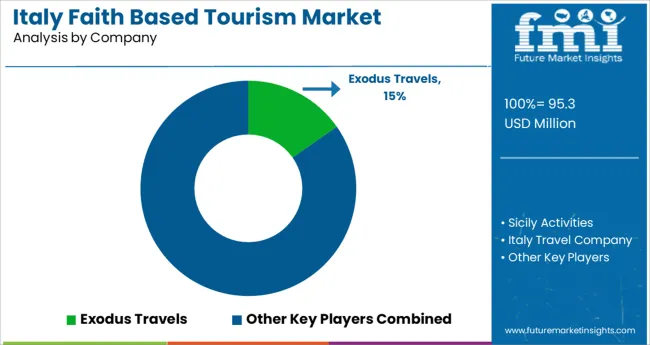
Key players operating in the Italy faith-based tourism market are focusing on launching customized tour packages to gain a competitive edge. A few other companies are aiming to offer several additional features, including meals, innovative spiritual activities, and accommodation with their packages to attract more tourists.
For instance,
Apart from the well-established tour companies across Italy, there are a large number of new entrants who are delivering unique itineraries to help tourists cover significant religious places across Italy. They are also providing online ticket booking facilities to save tourists from waiting in long queues at counters.
Some of the start-up firms are:
| Attributes | Details |
|---|---|
| Projected Market Valuation (2025) | USD 95.3 million |
| Value-based CAGR (2025 to 2035) | 9.8% |
| Forecast Period | 2025 to 2035 |
| Historical Data Available for | 2020 to 2024 |
| Market Analysis | Value (million) |
| Key Region Covered | Europe |
| Key Country Covered | Italy |
| Key Segments Covered | Tourism Type, Booking Channel, Tourist Type, Tour Type, Age Group, and Region. |
| Key Companies Profiled | Exodus Travels; Sicily Activities; Italy Travel Company; Hello Florence Tours Travel Srl; Venice Italy Travel; Luxury Rome Tou; Smart Trip; Show Me Italy; Real Italy Travel; LivTours; Argiletum; Italy Customized Srl; Miles & Miles Tours of Rome and Italy; Milan Visitor Center- Zani Viaggi; Michelangelo International Travel; Caf Tour & Travel; Cedars Travel; Through Eternity Tours; Rome Travels; Cosmos |
| Report Coverage | Market forecast, company share analysis, competition intelligence, Drivers, Restraints, Opportunities and Threats analysis, market dynamics and challenges, and strategic growth initiatives |
The global italy faith based tourism market is estimated to be valued at USD 95.3 million in 2025.
It is projected to reach USD 242.8 million by 2035.
The market is expected to grow at a 9.8% CAGR between 2025 and 2035.
The key product types are day trips & local gateways, museums, pilgrimages, religious and heritage tours and others.
women segment is expected to dominate with a 42.0% industry share in 2025.






Full Research Suite comprises of:
Market outlook & trends analysis
Interviews & case studies
Strategic recommendations
Vendor profiles & capabilities analysis
5-year forecasts
8 regions and 60+ country-level data splits
Market segment data splits
12 months of continuous data updates
DELIVERED AS:
PDF EXCEL ONLINE
Italy Women's Luxury Footwear Market Trends – Size, Demand & Forecast 2025-2035
Italy Tourism Market Analysis – Growth & Industry Trends 2024-2034
Italy Wine Tourism Market Report – Size, Share & Growth 2025-2035
Italy Casino Tourism Market Analysis 2025 to 2035
Italy Medical Tourism Market Size and Share Forecast Outlook 2025 to 2035
Italy Sustainable Tourism Market Size and Share Forecast Outlook 2025 to 2035
Demand for Bronte Pistachio in Italy Analysis - Size, Share & Forecast 2025 to 2035
Retail Sales of Bergamot from Calabria in Italy Analysis - Size, Share & Forecast 2025 to 2035
Trends, Growth, and Opportunity Analysis of Culinary Tourism in Italy Size and Share Forecast Outlook 2025 to 2035
Faith-Based Tourism Market Growth – Forecast 2024-2034
USA Faith Based Tourism Market Size and Share Forecast Outlook 2025 to 2035
UAE Faith-Based Tourism Market Trends – Growth & Forecast 2025 to 2035
Japan Faith-based Tourism Market Size and Share Forecast Outlook 2025 to 2035
India Faith-Based Tourism Market Trends - Growth & Forecast 2025 to 2035
Egypt Faith-Based Tourism Market Trends - Growth & Forecast 2025 to 2035
Brazil Faith-Based Tourism Market Trends - Growth & Forecast 2025 to 2035
Jordan Faith-Based Tourism Market Analysis – Trends & Forecast 2025 to 2035
Indonesia Faith-based Tourism Market Size and Share Forecast Outlook 2025 to 2035
South Africa Faith-Based Tourism Market Size and Share Forecast Outlook 2025 to 2035
Tourism Independent Contractor Model Market Size and Share Forecast Outlook 2025 to 2035

Thank you!
You will receive an email from our Business Development Manager. Please be sure to check your SPAM/JUNK folder too.
Chat With
MaRIA